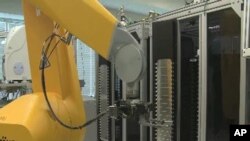The U.S. government recently unveiled its newest tool for safeguarding public health - a robot capable of screening thousands of chemicals each week for potential human toxicity. The robot is not only speeding up critical laboratory analyses, but also eliminating the controversial use of animals in product safety testing.
The high-speed robotic tester is revolutionizing routine chemical toxicity studies. Robert Kavlock is the Director of the National Center for Computation and Toxicology at the U.S. Environmental Protection Agency - EPA.
“A single human may work on ten chemicals a year, or 20," said Kavlock. "We are doing 10,000 in a week.”
The robot was jointly purchased by five big federal agencies that are collaborating to improve chemical testing procedures, including the EPA and the National Institutes of Health's Chemical Genomics Center, where the robot is located.
The plan is to create a comprehensive data library of toxic and harmful chemicals - a library that doesn't exist today. The robot is now testing chemicals found in industrial and consumer products, food additives and drugs, for evidence they might lead to adverse health effects.
Besides its speed, the robot offers scientists other benefits: it works 24 hours a day without complaining or asking for holidays or vacations. And it eliminates the need for live animals in the testing process, working only with animal cells arranged on special plates:
“On that plate are 1536 wells and...each well has a drop or two of solution. And we put on each one of those cells a single chemical, so we have 1536 chemicals on a single plate,” said Kavlock.
Each plate has a bar code label containing information about the chemical samples in those wells. The robot gets software instructions about what kind of biological activities to look for in the samples, and it tests for them very quickly. Once it is done, it sends the results to the scientists and waits for new instructions. The scientists, meanwhile, will evaluate what the data means in terms of toxicity, and whether a chemical can cause birth defects, reproductive problems or cancer.
“Industry will benefit because if we can develop a test that allows us to say whether a chemical is toxic or not toxic and we can do it for thousands of dollars and not millions of dollars, it becomes an economic benefit to industry to do it," said Kavlock. "It becomes a benefit to animal rights organizations concerned with how many animals we are using.”
Kavlock notes that there is no safety information on a lot of chemicals in use today. And about 1,500 new synthetic chemicals are introduced to the market every year in the United States. The new robot will give scientists a clearer picture of this torrent of chemical products, and help manufacturers and regulators separate the toxic stuff from the benign.












